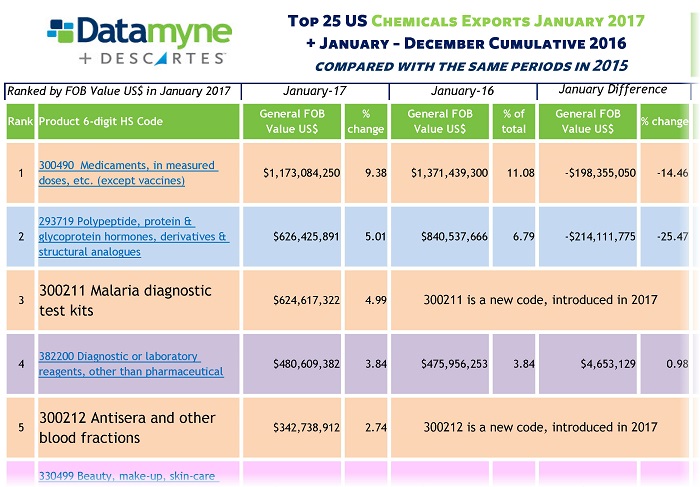New Harmonized System – or HS – tariff codes debuted with the New Year in the 2017 edition of the U.S. Harmonized Tariff System – or HTS. (What’s the difference between HS and HTS? See our FAQ here. More on the rollover can be found here in our complimentary whitepaper.)
The new tariff codes started surfacing in our monthly reports on top U.S. imports and exports by value of trade with January’s rankings. (Based on the latest available U.S. Census data, the reports list the top 25 imports-exports overall, agricultural products, chemicals, electronics, and metals and minerals in trade. All are posted for downloading in our free report library).
For example, ranked among January’s top U.S. chemicals exports was a new code for a product category not previously specified by the system: HS300460 designating Medicaments in measured doses containing antimalarial active principles.
New HS300211 Malaria diagnostic test kits (also previously unspecified) ranked 25th among U.S. exports overall, and 3rd among chemicals exports in January – as shown in this excerpt from January’s report:
[You can download the latest U.S. Chemicals Import-Export monthly ranking report here.]
HS300211 is one of five codes replacing the discontinued HS30021002, part of a reorganization of the HS3002 section covering antisera, other blood fractions and immunological products. The other four have all been prominent in U.S. chemicals trade in both directions through the first quarter:
- HS300212 Antisera & other blood fractions (No. 5 among January’s chemicals exports, as shown in the report excerpt above)
- HS300213 Immunological products unmixed not in measured doses, forms or packings for retail sale
- HS300214 Immunological products mixed not in measured doses, forms or packings for retail sale
- HS300215 Immunological products put up in measured doses, forms or packings for retail sale.
Also rising to the top ranks of U.S. chemicals imports in first quarter: new code HS293590 for Sulphonamides, others. This code is one of six that replace HS293500, each identifying a certain sulphonamide (e.g., HS293510 N-Methylperfluorooctane sulphonamide). Formerly batched under a single code, the new subheadings will aid monitoring and controlling these goods under the Rotterdam Convention.
These changes within the organic chemicals and pharmaceutical product categories are among 233 modifications to the tariff code system taking effect this year. You can find the complete U.S. HTS change record here.
New Tariff Codes for New Product Categories
The new tariff codes are the result of a five-year process of review and amendment of the global system of nomenclature for trade goods overseen by the World Customs Organization (WCO) and used by over 200 countries and Economic or Customs Unions.
The WCO’s principal goal is to ensure that the system clearly identifies what’s actually being bought, sold and subjected to tariffs. Some subheadings may be retired because trade in these products has receded. Headings for unglazed ceramic products such as tiles, flags and pavers (HS6907) and glazed ceramic products (HS6908) were merged under HS6907 because many of these products are no longer manufactured and trade in those remaining no longer makes a distinction between unglazed and glazed ceramics.
The trend, however, is to add new tariff codes for new products to keep pace with innovation, technological advances, changing consumer preferences as well as environmental concerns.
The 2017 edition of HS Nomenclature is the sixth; it contains 5,387 6-digit subheadings, 182 more than the 2012 edition. The 2012 edition introduced codes for lithium-ion batteries and “certified organic” agricultural products, for example. The 2017 edition offers new codes for non-alcoholic beer (HS220291), heavily-traded coniferous fuel wood (HS440111) and non-coniferous fuel wood (HS440112), as well as hybrid, plug-in hybrid and all-electric vehicles (HS870340 through HS870380). [See first-quarter 2017 data on electric vehicles.]
The 2017 edition also features many new individual codes for many more species of fish. According to WCO, the majority of changes in this edition were prompted by the Food and Agriculture Organization of the United Nations (FAO). The objective is closer monitoring for food security and for resource management. Similarly, forestry products have been assigned new codes to track trade in individual species, with special interest in the endangered.
HS 2017 adds classifications to monitor trade in substances controlled under the Chemical Weapons Convention, hazardous chemicals controlled under the Rotterdam Convention (such as the sulphonamides mentioned above), and persistent organic pollutants controlled under the Stockholm Convention.
In total, the 2017 edition contains 233 sets of amendments: 85 relating to the agricultural sector; 45 to the chemical sector; 13 to the wood sector; 15 to the textile sector; 25 to the machinery sector; 18 to the transport sector; and an additional 32 that apply to a variety of other sectors.
Finding Continuity in Change
The new tariff codes will yield more refined data, making it easier to manage resources and control risks over the long term.
In the short term, code revisions break the continuity in trade data and can disrupt systems that rely on standardized data streams. As we said at the top, we see the break in the free monthly ranking reports we issue each month. We can cover that break with an asterisk.
Shippers, manufacturers, retailers, and compliance professionals who must correctly classify items and analyze tariffs face a more complex and higher-stakes challenge. Businesses require the blend of the right technology platform and accurate trade content to offset the challenges posed by HS 2017, as well as fluctuating duties, taxes and Free Trade Agreements (FTAs).
Descartes Customs InfoTM offers a range of solutions to help companies keep pace with WCO revisions and changing trade regulations, tariffs, opinion, export codes, Other Government Agency (OGA) information and much more.
From a web-based subscription service, to a robust online workbench, to Enterprise Resource Planning (ERP) connectivity, Descartes helps maximize the value of trade data by helping organizations work smarter.
To find out more, just ask us, or download our complimentary white paper, Responding Successfully to WCO 2017 HS Reform, Enabling a Plan of Action to Streamline the Transition.
Related:




